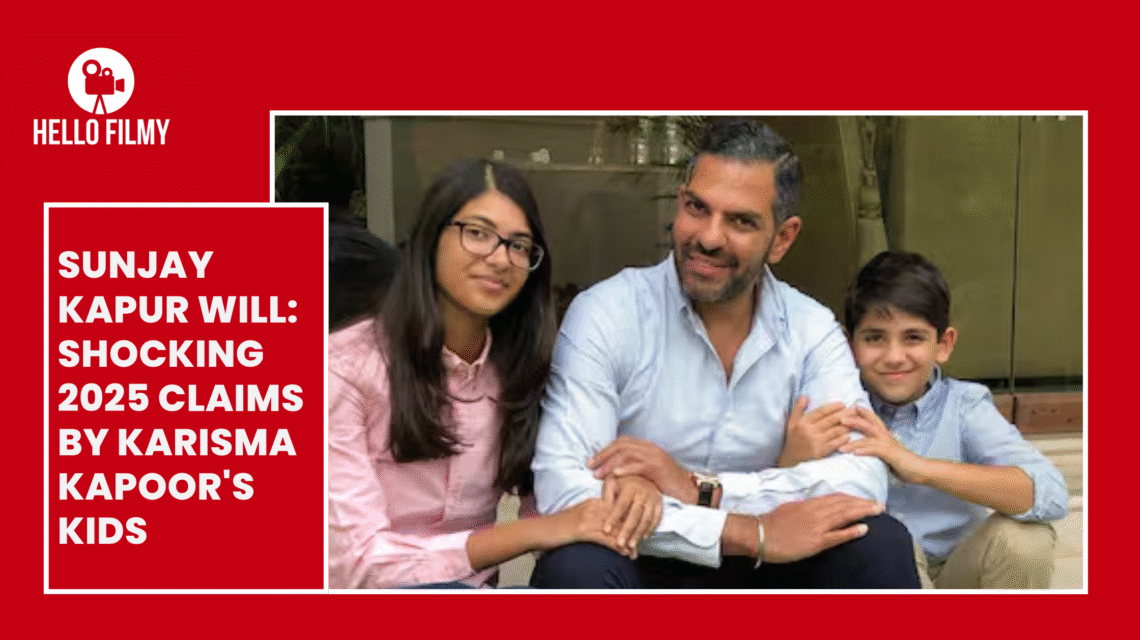Sunjay Kapur Will has become the focal point of a dramatic legal dispute as Karisma Kapoor’s children allege that the document was fabricated, not drafted by the industrialist himself. The Delhi High Court proceedings unfold like a courtroom thriller, where metadata, WhatsApp chats, and a supposed chain of custody are under the microscope. The case centers on a Rs 30,000-crore estate and tests the boundaries of digital evidence in India’s inheritance framework.
The broader backdrop is the story of Sunjay Kapur, a scion of the prominent Sona BLW automotive group, and a family saga that spans marriages, trust structures, and a vast portfolio of assets. While the public has long known Sunjay Kapur as a successful industrialist, the ongoing litigation raises fundamental questions about how modern wills are created, stored, shared, and challenged in court.
At the heart of the matter is a document presented as the will of Sunjay Kapur. The two children from his second marriage, Samaira and Kiaan Kapur, who share Karisma Kapoor as their mother, argue that the will did not originate from the testator’s own hands. Their counsel contends that the file was created and edited on another man’s computer, with metadata pointing to Nitin Sharma, a person with no formal connection to Sunjay Kapur. The claim is that a deliberate digital manipulation occurred to divert the estate entirely to the third wife, Priya Kapur. This framing turns a private inheritance dispute into a crucial test case for the role of digital footprints in Indian probate law.
As the court weighs the authenticity of the document, the case is also a window into how metadata, file formats, and electronic records travel through the hands of a private family and a corporate promoter group. The proceedings promise to redefine not just the wealth distribution within a single family, but the evidentiary standards that Indian courts rely on when confrontations arise over digital documents in inheritance matters.
Background: Sunjay Kapur, the Estate, and the Stakes
The subject of the will is a vast and diversified estate tied to Sunjay Kapur and the Sona BLW group. The litigation stakes are immense: a reported Rs 30,000 crore estate, protective family arrangements, and a legacy that intersects both business and high-profile public life. The case frames the tension between traditional testamentary practices and the modern realities of electronic documents, editing history, and remote storage. For the family, the outcome will shape not only financial trajectories but perceptions of credibility in a world where the digital trail is increasingly decisive.
What makes the claims particularly stark is the assertion that the will was conceived, edited, and ultimately distributed in ways that leave the true author—Sunjay Kapur himself—aside from the process. The legal team representing Samaira and Kiaan emphasizes an absence of a credible chain of custody and points to inconsistencies that a meticulous executive of Sunjay Kapur’s stature would likely avoid. The larger question, though, is how such a document could survive into a formal probate process if its authenticity is in doubt.
The Contested Will: Allegations of Fabrication and Digital Alteration
The core allegation is blunt: the will presented as Sunjay Kapur’s final testament was manufactured. Senior advocate Mahesh Jethmalani, representing Samaira and Kiaan, argued that the document’s origin is not the deceased’s hand or mind. He framed the will as a manufactured document created on another man’s computer, with metadata suggesting the file originated on the device of Nitin Sharma, a person with no formal connection to the Kapur family empire.
According to Jethmalani, the Word file was converted into a PDF on March 24 at 10:06 a.m., and only hours later a WhatsApp group named Family Office IC was formed to circulate the document among a select circle that included Sharma, Priya Kapur, and Dinesh Agarwal, a director of Aureus Investment Pvt Ltd under the Sona BLW promoter group. The timing has become a focal point: immediately after the document circulated, Priya Kapur reportedly responded with a simple
“Okay, thank you!”
—a response that, to the petitioners, reads as more transactional than ceremonial, raising questions about whether the testament reflected the deceased’s intentions at all.
The arguments emphasize digital footprints and missing links—if the will truly originated in Sunjay Kapur’s mind, why would the initial version require edits and re-creations on someone else’s device? Why would the file appear only after cremation, and what explains the absence of a transparent chain of custody for such a critical document? The petitioners insist that without a pristine, auditable trail, the will cannot be reconciled with the deceased’s character and precision in business affairs.
Evidence Pieces: Metadata, WhatsApp, and the Chain of Custody
Central to the case are the digital footprints that the petitioners argue point away from the deceased’s own hand. Metadata can reveal the authoring device, the editing timeline, and the sequence of modifications. In this instance, the metadata is claimed to show edits both prior to and after Sunjay Kapur’s death, suggesting a coordinated effort to shape the final document posthumously. The timing of the PDF conversion and the rapid formation of a WhatsApp group specifically built to circulate the will have become symbolic of a broader pattern of alleged manipulation.
Jethmalani’s team contends that the chain of custody—the documented path by which the document was stored, transferred, and preserved—has been broken. There is no clear record of where the original draft was stored, who had possession of it, or how it was altered. In a dispute of this scale, such gaps are not merely procedural; they are potentially fatal to the validity of a will that adopts an unconventional path to its circulation and execution.
Priya Kapur’s counsel counters with a different narrative, arguing that electronic evidence remains unimpeachable and that the will’s authenticity can be established through digital records and corroborating testimony. The case thus pivots on the credibility of electronic evidence and the interpretive framework used by the court to weigh metadata against traditional testamentary documents.
Internal Inconsistencies: Assets, Addresses, and Annotations
A striking feature of the contested will, as highlighted by the petitioners, is its internal inconsistency. The document lists three bank accounts in one section and six in another, while omitting critical properties and holdings—including Sunjay Kapur’s New York apartment, a 2010 family trust, and valuable assets such as jewellery, artwork, and precious metals. If a Harvard-educated industrialist with a reputation for precision drafted the will, the petitioners argue, such glaring discrepancies cannot be dismissed as clerical errors.
Even more telling, they say, are the incorrect addresses assigned to Samaira and Kiaan, coupled with multiple spellings of Sunjay Kapur’s youngest son Azarias’s name. Such errors, they contend, undermine the narrative of a carefully prepared document and instead point to a draft that was assembled hastily or manipulated after the fact. A meticulous father would not produce a document with these targeted inconsistencies, they insist, adding to the perception that the will’s appearance may be more performative than authentic.
Another missing section is the schedule of assets—a formal inventory that must accompany a will of this magnitude. The absence of an asset schedule has led the bench to describe the document as lacking the essential annexure that would normally anchor a testamentary disposition. In the eyes of the petitioners, a document that stands without a clear inventory cannot be treated as a final, complete testamentary instrument.
Procedural Lapses: The Asset Schedule, Executor, and Procedural Integrity
The court’s remarks have underscored a broader procedural concern: the absence of an inventory and a potential misalignment of executor designation. The pencil marks of improvisation—whether in the scheduling of assets or in the appointment of an executor whose role is to oversee the estate—sit uneasily with the image of a precise, Harvard-educated businessman who could be expected to leave a clean, auditable record. The bench described the absence of a detailed asset list as a serious procedural lapse, raising questions about whether due process was observed in the creation, storage, and circulation of the will.
Parties aligned with Priya Kapur argue that the case should be grounded in robust electronic evidence that supports the will’s authenticity rather than on an inventory-free document fraught with inconsistencies. They contend that the court should not prejudge the matter on the basis of formatting or minor errors, but rather evaluate the larger evidentiary framework that includes digital traces, witness testimony, and the overall trajectory of the document through custody channels.
The Court’s Stance and the Way Forward
The High Court acknowledged that the presented evidence raises substantial questions about the will’s origin and its internal coherence. The case was adjourned to a subsequent date to allow a deeper examination of the digital trail and the document’s custody history. The judges signaled that both the technical assessment of metadata and a close review of the original physical document would be essential to resolve the central question:
Who authored the will and who controlled its dissemination?
Priya Kapur’s side maintains that the electronic trail is unimpeachable. They argue that the will reflects the testator’s genuine intentions and that the digital footprints, when interpreted correctly, corroborate the document’s authenticity. Samaira and Kiaan, meanwhile, insist that memory and sentiment cannot override the weight of a digital record that appears to have been manipulated or created outside the deceased’s scope of control.
Implications for Inheritance Law and Digital Evidence in India
Beyond the immediate dispute, the Sunjay Kapur Will case touches on broader questions about how Indian courts will treat digital documents in probate proceedings. The rise of electronic wills, digital signatures, and metadata-rich documents is redefining the standards of proof for testamentary validity. Legal scholars and practitioners are watching closely for how the courts will balance traditional evidentiary norms—such as handwriting, witness testimony, and a signed paper will—with modern digital indicators that can be manipulated but also documented with a degree of precision previously unavailable.
Key implications include the need for a transparent chain of custody for electronic documents, a clear rule on the admissibility of metadata as evidence of authorship and intent, and robust safeguards to prevent tampering. The Sunjay Kapur Will case could accelerate reforms in estate planning, including standardized practices for digital archives, secure storage, and explicit procedures for probate courts to handle electronic will submissions. It may also influence how families structure wills that involve multiple marriages, complex asset pools, and cross-border holdings, where digital traces cross jurisdictional lines and custody chains become even more critical.
Timeline and What to Expect Next
While the courtroom has remained tight-lipped about forthcoming dates beyond the adjournment, observers expect a detailed forensic examination of metadata, a re-evaluation of the physical document, and perhaps additional witness testimony to establish the authenticity of the will. The timing of the next hearing will be watched closely by legal commentators, financial analysts, and the global Indian diaspora attached to Sunjay Kapur’s enterprises. Given the magnitude of the estate, the outcome will have ripple effects across corporate governance, family governance, and the management of legacy assets that define the Sona BLW promoter group and its affiliated entities.
The core issue remains whether the Sunjay Kapur Will represents the deceased’s true intentions or whether it reflects a digitally staged narrative designed to reallocate control and wealth. In either scenario, the case will likely become a landmark in how digital documents are treated in Indian probate courts, with enduring implications for families navigating similar conflicts in the future.
What This Means for Estate Planning in a Digital Age
For families and legal professionals, the Sunjay Kapur Will case underlines the importance of embracing robust digital governance in estate planning. Best practices emerging from this high-profile dispute include establishing secure document repositories, maintaining an auditable chain of custody for all electronic drafts, and ensuring independent notarization or attestation of final digital wills. In an era when a single click can alter ownership of billions, the steps taken today can determine whether a testamentary document stands up to judicial scrutiny tomorrow.
In practical terms, this means adopting technology-assisted solutions for will creation, including time-stamped digital signatures, multi-party access controls, and immutable storage. It also means preparing failsafe procedures for scenarios where the testator’s instructions could be contested, including clear succession plans, documented communications with heirs, and transparent disclosure of financial holdings. The Sunjay Kapur Will case thus serves as a cautionary tale about the fragility of digital records if proper safeguards are not in place—and a blueprint for how to future-proof estate planning in a rapidly evolving landscape.
Frequently Asked Questions
Q1: What is the central dispute in the Sunjay Kapur Will case?
A1: The central dispute concerns whether the Sunjay Kapur Will was authentically his, or whether it was digitally fabricated and manipulated to favor Priya Kapur. The case hinges on metadata, the chain of custody, and the document’s internal consistency.
Q2: What kind of evidence are the petitioners relying on?
A2: The petitioners rely on metadata proving edits and the file’s origin, the timing of the PDF conversion, the formation of a private WhatsApp group to circulate the document, and inconsistencies in asset listings and personal details that call into question the will’s authenticity.
Q3: How might this case affect Indian inheritance law?
A3: The case could set important precedents for the admissibility of digital evidence in probate matters, define acceptable standards for chain of custody in electronic wills, and influence how courts evaluate metadata as proof of authorship and intent in large family estates.
Q4: What should families take away for future estate planning?
A4: Families should adopt robust digital governance, secure storage for electronic wills, clear documentation of asset inventories, and independent attestations to ensure the testamentary process remains transparent and legally sound in the digital age.
Conclusion,
The Sunjay Kapur Will controversy is not just about a single document or a single family dispute. It is a pivotal moment in which Indian courts confront the realities of digital evidence, the reach of metadata, and the future of how estates are planned, verified, and contested in a world where documents can be created, edited, and circulated across platforms at the speed of a click. The outcomes will likely reverberate through courtroom corridors, corporate suites, and private family meetings for years to come, shaping the norms that govern how big legacies are safeguarded—or challenged—in the decades ahead.



 Sooraj Barjatya’s next film: Amazing Ultimate 2025 Blockbuster
Sooraj Barjatya’s next film: Amazing Ultimate 2025 Blockbuster  Sonakshi Sinha pregnancy rumours: Ultimate 2025 Positive Update
Sonakshi Sinha pregnancy rumours: Ultimate 2025 Positive Update  Dhurandhar Trailer: Ultimate 2025 Drop – Amazing November 12 Reveal
Dhurandhar Trailer: Ultimate 2025 Drop – Amazing November 12 Reveal  Ranveer Singh Agent Mode: Ultimate, Shocking Reveal in 2025
Ranveer Singh Agent Mode: Ultimate, Shocking Reveal in 2025  Khan Saab Father Death News: Punjabi Singer Mourns Father Iqbal Muhammad’s Demise, Heartbreaking Video Goes Viral
Khan Saab Father Death News: Punjabi Singer Mourns Father Iqbal Muhammad’s Demise, Heartbreaking Video Goes Viral  Varinder Singh Ghuman Death News: Vegetarian Bodybuilder and Actor Dies at 42
Varinder Singh Ghuman Death News: Vegetarian Bodybuilder and Actor Dies at 42